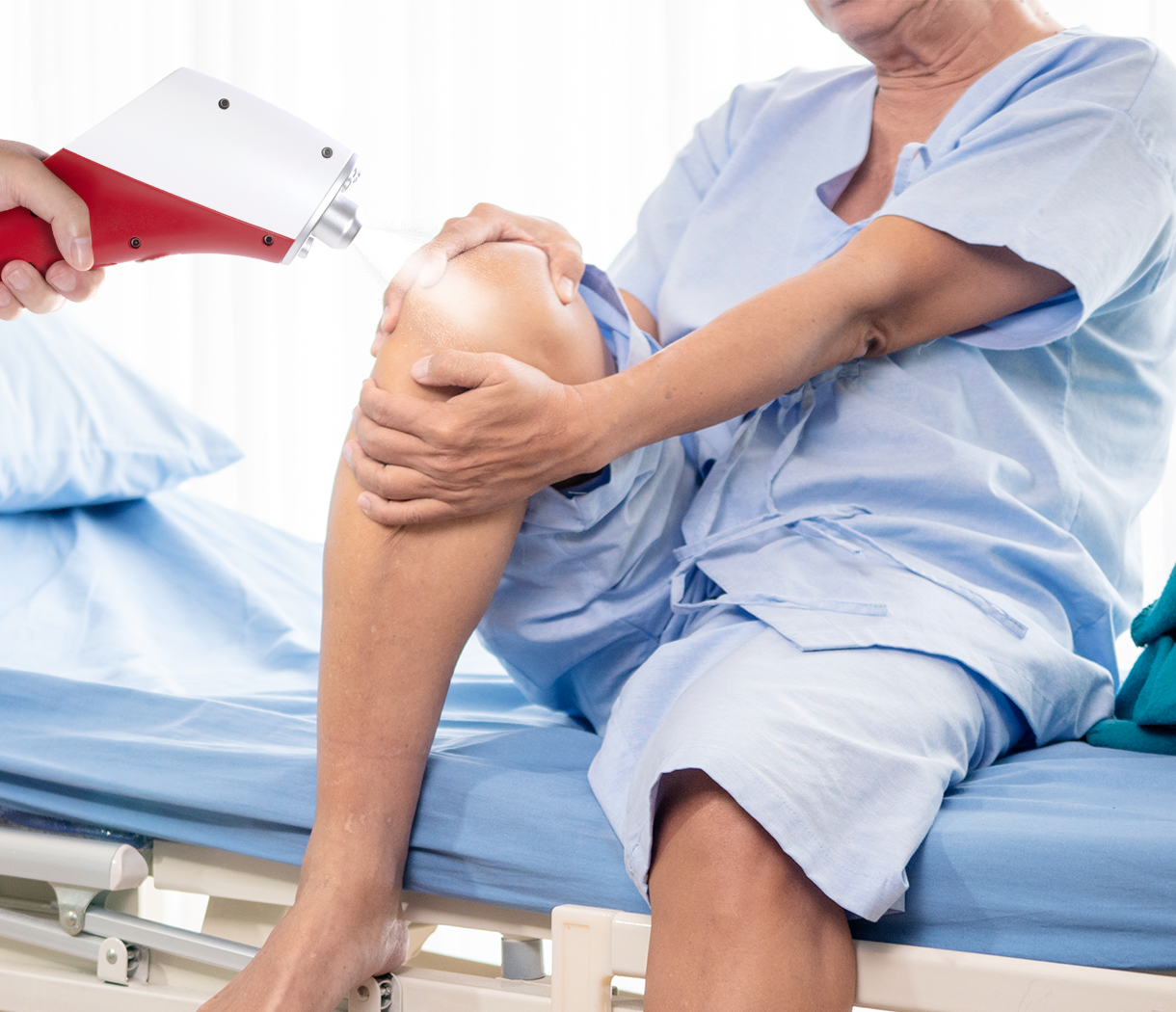Introduction to CO2 Cryotherapy and Its Benefits
What is CO2 Cryotherapy?
CO2 Cryotherapy is an innovative and non-invasive treatment that utilizes the therapeutic cooling effects of carbon dioxide (CO2) to enhance healing, reduce pain, and speed up recovery. CO2 Cryotherapy uses CO2 in either liquid or gas form to deliver localized cooling to specific areas of the body. This form of cryotherapy works by applying a burst or continuous flow of CO2 to the skin, lowering the temperature of the targeted tissue. This triggers a series of biological responses that reduce inflammation, promote healing, and accelerate recovery. It has gained significant attention in various fields, particularly in sports medicine, military recovery, and post-surgical rehabilitation, for its ability to effectively manage pain and inflammation in muscle and soft tissue injuries.
History and Evolution of CO2 Cryotherapy
Cold therapy for injury treatment dates back to the early 20th century, with ice and ice baths commonly used for acute injuries. CO2 Cryotherapy, however, was developed in the 1970s as a more targeted and controlled form of cold therapy. It quickly gained popularity for its ability to deliver faster and more precise relief compared to traditional methods. Initially used in laboratory settings to manage pain and reduce inflammation, it became integral to professional sports for accelerating recovery from intense physical exertion and injury. Over time, its applications expanded to include post-surgical recovery, physical therapy, and general wellness. Today, CO2 Cryotherapy has evolved into a highly effective treatment, backed by scientific research. It offers a safe, efficient alternative to traditional methods, promoting enhanced circulation, reduced tissue damage, and improved muscle recovery. As the therapy continues to grow, it is increasingly used by athletes and individuals with high physical demands.
Warrior-Level Injuries: The Challenges of Recovery
Warrior-level injuries are typically sustained by individuals engaged in high-intensity physical activities, such as athletes, military personnel, and those in physically demanding professions. These injuries often involve muscle strains, joint sprains, tendon injuries, and chronic inflammation. They can significantly impact an individual’s ability to perform at peak levels. Recovery from these injuries is complex, often requiring advanced therapeutic interventions that go beyond standard rest and rehabilitation methods.
Muscle Tears and Strains
Muscle strains and tears occur when muscle fibers are overstretched or torn, leading to swelling, pain, and a loss of mobility. These injuries are common among athletes engaged in sports that require explosive movements, such as sprinting, football, and weightlifting. Muscles that are repeatedly pushed to their limits are particularly prone to these injuries. The recovery process can take days, weeks, or even longer depending on the severity of the strain. The primary goal in treating muscle strains and tears is to reduce inflammation and promote tissue repair. Immediate pain management and longer-term rehabilitation are required to restore strength and flexibility.
Joint and Tendon Injuries
Joint and tendon injuries are also prevalent in high-performance athletes and individuals with physically demanding roles. Tendons, which connect muscles to bones, can become inflamed or torn due to repetitive strain or acute injury. Common tendon injuries include tendonitis, tendinosis, and tendon tears, often caused by the overuse of specific muscle groups or sudden impacts. Joint injuries, such as sprains, strains, and ligament tears, can occur from high-impact activities or improper movements. These injuries lead to pain, swelling, and a significant reduction in joint function. Recovery from joint injuries often requires more than just physical therapy and may take a considerable amount of time.
Chronic Pain and Inflammation
Chronic pain, particularly inflammation from past injuries or degenerative conditions like arthritis, can severely affect quality of life. Inflammatory conditions lead to ongoing pain and stiffness, limiting mobility and preventing full recovery. Whether from an injury or underlying condition, chronic pain requires specialized treatment to reduce inflammation and restore tissue function. Managing this type of pain is essential for improving daily function and enhancing quality of life.
How CO2 Cryotherapy Targets Warrior-Level Injuries
CO2 Cryotherapy is a highly effective tool for managing and recovering from warrior-level injuries, which are typically intense, complex, and require advanced treatment options. By harnessing the power of controlled cooling, CO2 Cryotherapy stimulates several biological processes that target the underlying causes of pain, inflammation, and tissue damage. Here’s how CO2 Cryotherapy addresses these critical aspects:

Pain Management Through Controlled Cooling
CO2 Cryotherapy provides significant pain relief by applying carbon dioxide to the injured area, which rapidly lowers the temperature and induces vasoconstriction (narrowing of blood vessels). This cooling effect reduces nerve activity and numbs the pain receptors temporarily. By minimizing the inflammatory response, CO2 Cryotherapy offers effective pain relief without medication. This is especially beneficial for injuries like muscle strains, tendon tears, or joint sprains, where traditional pain relief methods may be inadequate or involve heavy medication.
Accelerating Recovery Through Enhanced Blood Flow
After cooling, CO2 Cryotherapy causes blood vessels to dilate (vasodilation) during the warming phase, increasing blood flow to the treated area. Enhanced circulation accelerates recovery by improving nutrient and oxygen delivery to damaged tissues. This helps repair muscle fibers, tendons, and ligaments more quickly, reducing recovery time. The increase in circulation supports faster healing, especially for high-performance athletes returning to peak physical condition.
Reducing Inflammation and Swelling
CO2 Cryotherapy reduces inflammation and swelling through vasoconstriction and the flushing of inflammatory mediators. During the cooling phase, blood flow is reduced to the affected area, preventing fluid accumulation and minimizing swelling. The warming phase helps clear excess fluids, reducing swelling and alleviating pressure. This process not only relieves pain but also creates a better environment for tissue healing, ensuring that inflammation doesn’t hinder recovery.
Tissue Regeneration and Scar Tissue Reduction
CO2 Cryotherapy stimulates tissue regeneration by encouraging cellular repair and collagen production. The enhanced circulation supports the healing of muscles, tendons, and ligaments. Additionally, it helps reduce scar tissue formation, which can limit flexibility and function in the affected area. By promoting healthy tissue regeneration and minimizing scar tissue, CO2 Cryotherapy ensures that the area heals with optimal mobility and strength.
Real-World Applications of CO2 Cryotherapy for Warrior-Level Injuries

CO2 Cryotherapy has found valuable applications in a wide range of settings, particularly for individuals recovering from high-intensity injuries, such as those experienced by athletes, military personnel, and patients undergoing post-surgical rehabilitation. By addressing both immediate pain and long-term recovery, CO2 Cryotherapy offers an effective treatment option in several high-demand environments.
Elite Athletes and Professional Recovery
For elite athletes, recovery is key to maintaining peak performance. High-impact sports like football, soccer, rugby, and track & field cause frequent injuries, such as sprains, strains, and muscle tears. CO2 Cryotherapy is now an essential part of recovery routines for many professional athletes. It helps speed up recovery, reduce muscle soreness, and minimize inflammation, enabling athletes to perform at their best in the next competition or training session. CO2 Cryotherapy also helps prevent injuries by aiding recovery between sessions. It enhances muscle function, flexibility, and endurance, reducing the risk of overuse injuries. As a proactive measure, many athletes rely on CO2 Cryotherapy to maintain physical health and avoid injury.
Military and Tactical Recovery
Military personnel and first responders experience intense physical strain, whether during combat, training, or tactical operations. CO2 Cryotherapy is an effective treatment for injuries like sprains, strains, and muscle fatigue commonly seen in these environments. In the military, CO2 Cryotherapy is used for quick recovery, allowing soldiers to return to duty faster. It reduces downtime and accelerates tissue healing, essential for maintaining readiness. The therapy also helps manage chronic pain and inflammation resulting from long-term physical stress, making it a vital recovery tool for tactical personnel.
Post-Surgery Rehabilitation
Post-surgery recovery, particularly after orthopedic or soft tissue surgeries, is often slow and painful, involving swelling, pain, and limited mobility. CO2 Cryotherapy helps address these issues by reducing swelling, alleviating pain, and speeding up tissue healing. It’s commonly used for joint replacements, ligament repairs, and tendon reconstructions. By incorporating CO2 Cryotherapy into the post-surgery recovery phase, patients can experience faster rehabilitation, reduced reliance on pain management treatments, and fewer complications like scarring. This speeds up recovery times and improves overall outcomes.
CO2 Cryotherapy for Performance Enhancement and Injury Prevention
In addition to aiding recovery, CO2 Cryotherapy has proven benefits for enhancing performance and preventing injuries in athletes, fitness enthusiasts, and active individuals. By improving circulation, reducing inflammation, and promoting healing, CO2 Cryotherapy supports long-term physical health and helps individuals stay in peak condition.
Boosting Circulation and Nutrient Delivery for Faster Recovery
Effective circulation is critical to the recovery process, as it ensures that injured tissues receive the oxygen, nutrients, and growth factors needed for repair. CO2 Cryotherapy boosts circulation by first inducing vasoconstriction (narrowing of blood vessels) followed by vasodilation (widening of blood vessels). This process improves blood flow and accelerates the delivery of essential nutrients to the healing tissues. The improved circulation not only speeds up the recovery of injured tissues but also promotes overall health and wellness. Active individuals can benefit from CO2 Cryotherapy by supporting their body’s natural repair processes, which helps prevent fatigue and ensures optimal performance during exercise and training.
Reducing Recovery Time Between Intensive Workouts or Training Sessions
For those who train intensely, whether professionally or as part of a fitness routine, minimizing recovery time between sessions is crucial. CO2 Cryotherapy helps reduce muscle soreness, inflammation, and fatigue, allowing individuals to train more frequently without the risk of overuse injuries. By utilizing CO2 Cryotherapy as part of a regular recovery regimen, athletes and fitness enthusiasts can bounce back more quickly from their workouts. The reduced recovery time allows them to maintain higher levels of training intensity and improve their overall performance, leading to better results over time.
Preventative Benefits: Minimizing Injury Risk
One of the most important aspects of CO2 Cryotherapy is its ability to prevent injuries before they occur. By using CO2 Cryotherapy regularly, athletes and active individuals can reduce muscle tightness, inflammation, and fatigue that often lead to injuries. This proactive approach to injury prevention helps individuals stay in peak physical condition, reducing the likelihood of strains, sprains, and other common injuries. For athletes and military personnel, using CO2 Cryotherapy as part of a comprehensive injury prevention strategy ensures that they can perform at their highest level with minimal downtime. By addressing early signs of strain and fatigue, CO2 Cryotherapy helps maintain peak performance and reduces the risk of long-term injury.
Safety Considerations and Best Practices for CO2 Cryotherapy
Who Should Use CO2 Cryotherapy?
CO2 Cryotherapy can be highly effective for a range of individuals, particularly athletes, fitness enthusiasts, and those recovering from injuries. However, it may not be suitable for everyone.

Ideal Candidates:
- Athletes: Especially those involved in high-impact sports such as football, basketball, and running, who frequently experience muscle strains and joint injuries.
- Post-Surgery Patients: Individuals recovering from surgeries like joint replacement or ligament repair can benefit from CO2 Cryotherapy to accelerate healing and reduce pain.
- Chronic Pain Sufferers: Those suffering from long-term pain conditions, including arthritis or fibromyalgia, can experience pain reduction and enhanced mobility.
Precautions for Specific Conditions:
People with certain medical conditions, such as cold-induced urticaria (cold-induced hives) or Raynaud’s disease, should avoid CO2 Cryotherapy. Pregnancy and severe cardiovascular diseases may also be contraindications, and it’s always essential to consult a healthcare professional before starting treatment.
How Often Should You Use for Optimal Results?
The frequency of CO2 Cryotherapy treatments can vary based on the type of injury, the severity of symptoms, and the individual’s recovery goals.
- Acute Injuries: During the early stages of recovery (acute phase), 3-5 sessions per week may be recommended to speed up healing and reduce swelling.
- Chronic Conditions: For chronic pain management or to maintain peak performance, weekly or bi-weekly sessions are typically sufficient.
- Maintenance Therapy: Once significant recovery has been achieved, treatments can be reduced to 1-2 sessions per month to maintain flexibility, pain relief, and prevent re-injury.
Monitoring and Evaluating Effectiveness
Tracking Progress: Patients should monitor changes in pain levels, mobility, and overall function after each session. If pain persists or worsens, the treatment protocol may need adjustment.
Regular Assessments: Continuous evaluation by healthcare professionals ensures that the therapy is effective and that treatment is tailored to the individual’s needs. Re-assessment should be done after 5-10 sessions to evaluate overall improvement and determine the necessity for ongoing therapy.
Success Stories and Patient Testimonials
Real-Life Recovery Cases
Case 1: Professional Basketball Player
A professional basketball player suffering from a hamstring strain experienced a significant reduction in pain and swelling after 8 CO2 Cryotherapy sessions, allowing him to return to full training within weeks, significantly reducing downtime compared to traditional methods.
Case 2: Post-Surgical Recovery
A 50-year-old woman recovering from knee replacement surgery experienced enhanced mobility and reduced swelling after undergoing CO2 Cryotherapy. Her post-operative recovery time was shortened by 30%, and she returned to normal activities quicker than expected.
Case 3: Chronic Back Pain
A patient suffering from chronic lower back pain due to degenerative disc disease reported a significant reduction in pain intensity and improved range of motion after 10 CO2 Cryotherapy sessions, allowing her to engage in daily activities with ease.
Expert Opinions and Clinical Research Results
Dr. Sarah Miller, Orthopedic Specialist: “CO2 Cryotherapy has proven to be an excellent adjunct to physical therapy for pain management and recovery. It accelerates healing at a cellular level and reduces inflammation, which is essential for optimal recovery.”
Clinical Findings: According to a study published in Journal of Sports Science and Medicine, athletes who underwent CO2 Cryotherapy showed a 20-30% reduction in recovery time and reported 40% improvement in muscle flexibility compared to those who did not use cryotherapy.
Comparison with Other Recovery Treatments

Traditional Ice Therapy: While ice therapy reduces swelling, it does not accelerate tissue repair. In contrast, CO2 Cryotherapy stimulates blood circulation and enhances the delivery of oxygen and nutrients, leading to faster recovery.
Corticosteroid Injections: Corticosteroid injections may provide immediate pain relief but have potential side effects such as weakening of tissues. CO2 Cryotherapy is non-invasive and promotes natural healing, with fewer risks and long-term benefits.
Massage Therapy: Both therapies aid in muscle recovery, but CO2 Cryotherapy reaches deeper tissues, enhancing circulation and accelerating recovery more efficiently. Massage therapy can also be incorporated alongside CO2 Cryotherapy for a more comprehensive approach.
FAQs about CO2 Cryotherapy for Warrior-Level Injuries
Q1. How long does it take to see results from CO2 Cryotherapy?
Most patients notice pain relief and reduced swelling within the first few sessions. Full recovery can take 3-5 weeks, depending on the severity of the injury.
Q2. Can CO2 Cryotherapy be used for all types of injuries?
Yes, it’s effective for muscle strains, ligament injuries, joint inflammation, and post-surgical recovery. However, always consult a professional before beginning treatment.
Q3. How often should CO2 Cryotherapy be used for best results?
2-3 sessions per week are typically recommended during the acute recovery phase. As the injury heals, the frequency can be reduced.
Q4. Are there any side effects of CO2 Cryotherapy?
Side effects are minimal. Some individuals may experience temporary redness or numbness in the treated area. These effects typically subside quickly.
Q5. How long does a CO2 Cryotherapy session last?
Each session typically lasts between 10 to 15 seconds. Treatment times may vary based on the severity of the injury.
Q6. Is CO2 Cryotherapy safe for elderly individuals or children?
Yes, it is safe for both, but the frequency and intensity may need to be adjusted based on the individual’s health and age. Consult with a healthcare provider beforehand.
Q7. Can CO2 Cryotherapy be used for injury prevention?
Yes, regular use can help minimize the risk of injuries by improving circulation, reducing muscle stiffness, and preventing overuse injuries, especially in high-performance athletes.
References
Cryotherapy with carbon dioxide hydrate enhances immediate recovery of muscle function from neuromuscular fatigue:
https://www.tandfonline.com/doi/full/10.1080/02640414.2024.2423135
Use of Cryotherapy for Managing Chronic Pain: An Evidence-Based Narrative:



